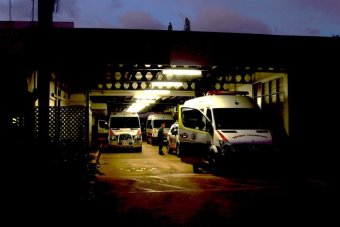Northern Territory paramedics are set to receive boosted violence-avoidance training, as the region’s ambulance officers call for more help battling attacks on the job.
Michael McKay, director of St John NT, the not-for-profit organisation contracted by the NT government to respond to emergency medical call-outs, told 105.7 ABC Darwin that new forms of de-escalation and defensive training will be introduced next month.
The training comes after several incidents against Territory paramedics in the last few months, notably the assault of Darwin paramedic Reece Ravlich in May.
This week Alice Springs paramedics were also allegedly attacked with rocks while helping patients on the job.
Alice Springs area manager for St John’s Ambulance, Matthew Eastham, told Alice Springs 783 the rock attack was “a very serious incident and another example of a very dangerous job”.
“We have instances on most days when our paramedics are put in danger,” he said.
“I myself have been in Alice Springs for eight weeks and the level of violence is like nothing I have ever seen before, especially the violence towards paramedics.”
An Alice Springs paramedic told local reporters this week that training to deal with aggressive or intoxicated patients had been “non-existent” to date in the Territory.
Mr McKay said next month’s violence-avoidance training was in response to feedback from paramedics that existing training “wasn’t good enough”.
Security officers and police escorts viable options: St John NT
Mr McKay, who has worked with St John NT for 25 years, said the level of violence against paramedics had not necessarily risen noticeably in recent years, but a rise in some types of substance abuse and medical issues had complicated matters.
“The complexity of dealing with patients is what’s changed. Before, you might be able to talk them down,” he said.
“There’s no rationalising with them. It’s like trying to reason with a drunk.”
Mr McKay said increasing legal repercussions for violence against paramedics would be little deterrence to patients experiencing such irrationality, and that St John NT’s main strategy was physical prevention.
“I’m hoping the day never comes that we need [security guards] for paramedics but if we need them to make it safe for them to do their job, that’s where we’ll end up,” he said.
Here I am, a 66-year-old old bloke with one lung. I’m a decrepit old man. I’ve never had [police] show up before.
Geoff Robb, Katherine resident
St John NT and NT Police have a longstanding working relationship to prevent violence, with police officers sometimes sent to notorious scenes ahead of resource-strapped ambulances.
In Katherine, about 300 kilometres south of Darwin, there is just one ambulance for the entire town and police officers often scope out scenes ahead of paramedics.
Geoff Robb, a 66-year-old pensioner who recently moved to Katherine from Darwin, was “shocked” when he called the town’s ambulance for help with breathing problems on Tuesday morning and two police officers also showed up.
Mr Robb lives in a public housing building in Katherine and had a long history of calling ambulances for help with his medical issues in Darwin.
“Here I am, a 66-year-old old bloke with one lung. I’m a decrepit old man. I’ve never had [police] show up before,” he said.
“I live in a housing commission but I don’t take drugs. I don’t blame them, but it was a bit of a shock.”
‘It’s horrendous and shouldn’t be happening’
Mr McKay said police were generally sent ahead of time to make “quick assessments” and their appearance was not a pre-judgement on the likelihood of patients, such as Mr Robb, being aggressive.
But he also said the use of police was another indication of the realities of being a paramedic in Australia.
“The involvement of police happens several times a night [in the Northern Territory]. It’s horrendous and it shouldn’t be happening,” he said.
“Aggression and violence towards paramedics in the Northern Territory, and not just the Northern Territory but across Australia, is high. It’s ridiculously high.”
Since 2009 there has been a 20 per cent increase in case numbers for St John NT — a figure that parallels the Territory’s 17 per cent population increase across a similar period.
In this time, the number of ambulances available around the clock has not changed, with four vehicles in Darwin and nine in the whole of the Territory.
The Government contracts out its road ambulance service to St John NT and provides about 90 per cent of its funding, with this year witnessing an industrial dispute over paramedics’ wages.


